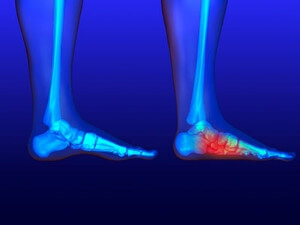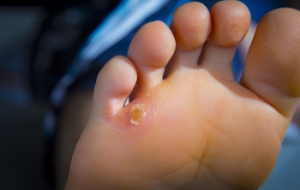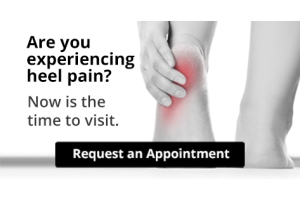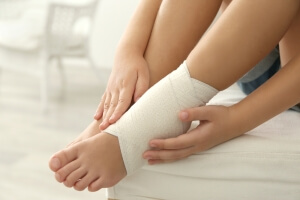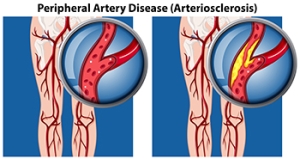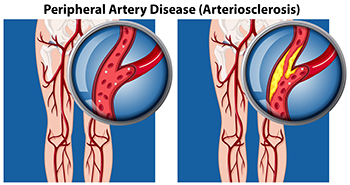Oceanside (760) 630-9200

Obese Children May Have Flatter Feet
 Flat feet is a condition in which there is no visible arch in the feet when the feet bear weight. While all babies are born with flat feet, in most children, the arch will develop slowly over time. However, obese children have been found to be more likely to retain their flat feet. This can be due to lowered arches caused by the excess strain that being overweight places on the feet, in addition to the extra fat padding found on the soles of obese children’s feet. Flat feet sometimes cause foot and ankle pain and can also contribute to back pain as children age. If your child has flat feet and complains of foot pain, please consult with a podiatrist.
Flat feet is a condition in which there is no visible arch in the feet when the feet bear weight. While all babies are born with flat feet, in most children, the arch will develop slowly over time. However, obese children have been found to be more likely to retain their flat feet. This can be due to lowered arches caused by the excess strain that being overweight places on the feet, in addition to the extra fat padding found on the soles of obese children’s feet. Flat feet sometimes cause foot and ankle pain and can also contribute to back pain as children age. If your child has flat feet and complains of foot pain, please consult with a podiatrist.
The more you weigh, the harder your feet must work to support your body. If you’re an obese individual and are concerned about your feet, contact Dr. Jeff Brooks from Oceanside Foot & Ankle Center. Our doctor can provide the care you need to keep you pain-free and on your feet.
Obesity and Your Feet
People who are overweight are putting more pressure on their ankles, knees, and hips as well as their feet. This unfortunately can lead to variety of different issues.
Problems & Complications Stemming from Obesity
- When the body is overweight, it tries to compensate by changing the way that it moves. An obese person may lean forward and put extra weight on the wrong part of the foot. This puts unnecessary stress on the feet.
- Obese people are also more likely to develop type II diabetes which is a condition that causes a lot of foot problems. People with diabetes often don’t feel the cuts and sores that they may have on their feet, which can lead to more complicated and severe issues.
- Plantar fasciitis is another foot condition that can be caused by obesity. Plantar fasciitis is an inflammation of the tissue along the bottom of the foot, which causes pain and stiffness while walking and climbing stairs.
If you have any questions, please feel free to contact our office located in Oceanside, CA . We offer the newest diagnostic and treatment technologies for all your foot care needs.
Obesity and the Feet
Obesity is a common problem in American society. Approximately one third of the U.S. population is obese. Obesity is defined as a body mass index greater than 30. Obesity has the power to affect different aspects of the body, and one of the most common problems it causes is foot pain. There have been many studies that found a connection between an increased BMI and foot problems. A simple activity such as walking up a flight of stairs can increase pressure on the ankle by four to six times.
Being overweight causes the body to compensate for the extra weight by changing the way it moves. Consequently, people who struggle with obesity commonly have arch problems in their feet. Obesity causes the arch to break by stretching the ligaments and tendons that hold the bones in the foot together. When the arch lowers, the foot may eventually fall flat. Collapsed foot arches fail to provide adequate shock absorption which eventually leads to foot pain. Other conditions that may be caused by flat feet are pronation, plantar fasciitis, weak ankles, and shin splints.
Foot problems that are caused by obesity may be treated by wearing proper footwear. Proper shoes will allow your feet to have better circulation around the arch and ankle. Additionally, those with obesity often discover that typical heel pain remedies are not effective for them. They will find that their plantar fascia is easily injured, and it is often inflamed. The best way to treat this problem is to implement lifestyle changes. A few good ways to improve your diet are to reduce calories, fill up on fruits and veggies, and to limit sugars.
Custom foot orthotics can prevent foot problems if you’re carrying excess weight or are trying to lose weight. The purpose of orthotics is to provide shock absorption to decrease the amount of stress on the joints to prevent arthritis.
Treatments for Corns
 Corns are calluses which often form over the skin of the toes and feet in response to excessive pressure or friction on the area. Corns on the feet can be unpleasant and even painful. Fortunately, there are many treatments for corns. In the clinic, a doctor can trim the corn by shaving the dead skin cells away with a scalpel. At home, soaking the feet regularly and using a pumice stone to exfoliate the foot can soften and reduce the size of the corn. Wearing a specialized pad or cushion can decrease pain, while wearing well-fitted and comfortable shoes can prevent future corns from developing. If you have painful foot corns, it is suggested that you see a podiatrist.
Corns are calluses which often form over the skin of the toes and feet in response to excessive pressure or friction on the area. Corns on the feet can be unpleasant and even painful. Fortunately, there are many treatments for corns. In the clinic, a doctor can trim the corn by shaving the dead skin cells away with a scalpel. At home, soaking the feet regularly and using a pumice stone to exfoliate the foot can soften and reduce the size of the corn. Wearing a specialized pad or cushion can decrease pain, while wearing well-fitted and comfortable shoes can prevent future corns from developing. If you have painful foot corns, it is suggested that you see a podiatrist.
If you have any concerns regarding your feet and ankles, contact Dr. Jeff Brooks of Oceanside Foot & Ankle Center. Our doctor will treat your foot and ankle needs.
Corns: What Are They? and How Do You Get Rid of Them?
Corns can be described as areas of the skin that have thickened to the point of becoming painful or irritating. They are often layers and layers of the skin that have become dry and rough, and are normally smaller than calluses.
Ways to Prevent Corns
There are many ways to get rid of painful corns such as wearing:
- Well-fitting socks
- Comfortable shoes that are not tight around your foot
- Shoes that offer support
Treating Corns
Treatment of corns involves removing the dead skin that has built up in the specific area of the foot. Consult with Our doctor to determine the best treatment option for your case of corns.
If you have any questions please feel free to contact our office located in Oceanside, CA . We offer the newest diagnostic and treatment technologies for all your foot and ankle needs.
Understanding Corns and Calluses
Corns and Calluses are both hardened layers of thickened skin that develop because of friction. Both ailments are typically found on the feet and may be unsightly. Although they have similarities, corns and calluses are different from each other.
Some causes of corns and calluses may be wearing ill-fitting shoes and not wearing socks. If you wear tight shoes, your feet will constantly be forced to rub against the shoes, causing friction. If you fail to wear socks, you are also causing your feet to endure excess friction.
There are some signs that may help you determine whether you have one of these two conditions. The first symptom is a thick, rough area of skin. Another common symptom is a hardened, raised bump on the foot. You may also experience tenderness or pain under the skin in addition to flaky, dry, or waxy skin.
There are also risk factors that may make someone more prone to developing corns and calluses. If you are already dealing with bunions or hammertoe, you may be more vulnerable to having corns and calluses as well. Other risk factors are foot deformities such as bone spurs, which can cause constant rubbing inside the shoe.
Corns tend to be smaller than calluses and they usually have a hard center surrounded by inflamed skin. They also tend to develop on the parts of the body that don’t bear as much weight such as the tops and sides of toes. Corns may also be painful for those who have them. On the other hand, calluses are rarely painful. These tend to develop on the bottom of the feet and may vary in size and shape.
Fortunately, most people only need treatment for corns and calluses if they are experiencing discomfort. At home treatments for corns and calluses should be avoided, because they will likely lead to infection. If you have either of these ailments it is advised that you consult with your podiatrist to determine the best treatment option for you.
What Is Tenosynovitis?
 Tenosynovitis is an ailment in which the tendon sheath, the layer of tissue that surrounds each tendon in the body, becomes inflamed. This often occurs in the tendons of the lower limbs, and particularly in the tendons of the ankle. The tendon sheaths in the ankle can become inflamed from repetitive activities that strain them, such as walking or running for long distances. Symptoms of ankle tenosynovitis include pain, tenderness, swelling, and difficulty moving the ankle. Tenosynovitis usually responds well to conservative treatments, such as resting and immobilizing the affected ankle and taking over the counter pain medications. For more information about tenosynovitis, please consult with a podiatrist.
Tenosynovitis is an ailment in which the tendon sheath, the layer of tissue that surrounds each tendon in the body, becomes inflamed. This often occurs in the tendons of the lower limbs, and particularly in the tendons of the ankle. The tendon sheaths in the ankle can become inflamed from repetitive activities that strain them, such as walking or running for long distances. Symptoms of ankle tenosynovitis include pain, tenderness, swelling, and difficulty moving the ankle. Tenosynovitis usually responds well to conservative treatments, such as resting and immobilizing the affected ankle and taking over the counter pain medications. For more information about tenosynovitis, please consult with a podiatrist.
Ankle pain can be caused by a number of problems and may be potentially serious. If you have ankle pain, consult with Dr. Jeff Brooks from Oceanside Foot & Ankle Center. Our doctor will assess your condition and provide you with quality foot and ankle treatment.
Ankle pain is any condition that causes pain in the ankle. Due to the fact that the ankle consists of tendons, muscles, bones, and ligaments, ankle pain can come from a number of different conditions.
Causes
The most common causes of ankle pain include:
- Types of arthritis (rheumatoid, osteoarthritis, and gout)
- Ankle sprains
- Broken ankles
- Achilles tendinitis
- Achilles tendon rupture
- Stress fractures
- Bursitis
- Tarsal tunnel syndrome
- Plantar fasciitis
Symptoms
Symptoms of ankle injury vary based upon the condition. Pain may include general pain and discomfort, swelling, aching, redness, bruising, burning or stabbing sensations, and/or loss of sensation.
Diagnosis
Due to the wide variety of potential causes of ankle pain, podiatrists will utilize a number of different methods to properly diagnose ankle pain. This can include asking for personal and family medical histories and of any recent injuries. Further diagnosis may include sensation tests, a physical examination, and potentially x-rays or other imaging tests.
Treatment
Just as the range of causes varies widely, so do treatments. Some more common treatments are rest, ice packs, keeping pressure off the foot, orthotics and braces, medication for inflammation and pain, and surgery.
If you have any questions, please feel free to contact our office located in Oceanside, CA . We offer the newest diagnostic and treatment technologies for all your foot care needs.
Ankle Pain
Pain experienced in the ankle can be caused by a multitude of conditions. While the most common cause is an ankle sprain, other possible problems can include arthritis, gout, ankle instability, an ankle fracture, nerve compression, or tendinitis. In more serious cases, ankle pain can be a sign of improper alignment of the foot or an infection.
Ankle pain can often be accompanied by symptoms such as redness, swelling, stiffness, and warmth in the affected area. Pain can be described differently depending on the condition: short, stabbing pain and a dull ache are some examples. If such symptoms are persistent and do not improve after time, be sure to schedule an appointment with your local podiatrist.
Depending on the condition causing your ankle pain, different treatments may be prescribed by your podiatrist. For ankle sprains, the first step in treatment involves rest, ice, elevation, and compression. Be sure to avoid placing pressure on the ankle, use an ice pack several times a day, and use a compression bandage and elevation to reduce swelling. Other, more serious conditions may require the assistance of certain drugs and medications such as nonsteroidal anti-inflammatory drugs (NSAIDs), physical therapy, or even cortisone injections.
Depending on the severity of your ankle pain and the condition behind it, recovery from ankle pain may take some time.
Consult with your foot and ankle doctor to best determine the cause of your ankle pain and the appropriate treatment.
Am I at Risk for Peripheral Artery Disease?
Peripheral artery disease (PAD) is a medical condition that causes poor circulation in the lower limbs due to plaque buildup in the arteries. Plaque buildup causes blockages in the arteries, making them narrow and harden. This makes it more difficult for the blocked off area to receive an adequate blood supply. Certain people are at an increased risk of developing PAD, including people who smoke, have a family history of PAD, heart attack, stroke, high blood pressure, or high cholesterol. Those who are over the age of 50, are overweight, or have diabetes are also at risk. While PAD may be asymptomatic in its initial stages, it can eventually cause leg pain and lead to further complications. If you are at risk for PAD, a podiatrist can screen you for this condition and help you manage it. For more information about PAD, please consult with a podiatrist.
Peripheral artery disease can pose a serious risk to your health. It can increase the risk of stroke and heart attack. If you have symptoms of peripheral artery disease, consult with Dr. Jeff Brooks from Oceanside Foot & Ankle Center. Our doctor will assess your condition and provide you with quality foot and ankle treatment.
Peripheral artery disease (PAD) is when arteries are constricted due to plaque (fatty deposits) build-up. This results in less blood flow to the legs and other extremities. The main cause of PAD is atherosclerosis, in which plaque builds up in the arteries.
Symptoms
Symptoms of PAD include:
- Claudication (leg pain from walking)
- Numbness in legs
- Decrease in growth of leg hair and toenails
- Paleness of the skin
- Erectile dysfunction
- Sores and wounds on legs and feet that won’t heal
- Coldness in one leg
It is important to note that a majority of individuals never show any symptoms of PAD.
Diagnosis
While PAD occurs in the legs and arteries, Podiatrists can diagnose PAD. Podiatrists utilize a test called an ankle-brachial index (ABI). An ABI test compares blood pressure in your arm to you ankle to see if any abnormality occurs. Ultrasound and imaging devices may also be used.
Treatment
Fortunately, lifestyle changes such as maintaining a healthy diet, exercising, managing cholesterol and blood sugar levels, and quitting smoking, can all treat PAD. Medications that prevent clots from occurring can be prescribed. Finally, in some cases, surgery may be recommended.
If you have any questions, please feel free to contact our office located in Oceanside, CA . We offer the newest diagnostic and treatment technologies for all your foot care needs.

